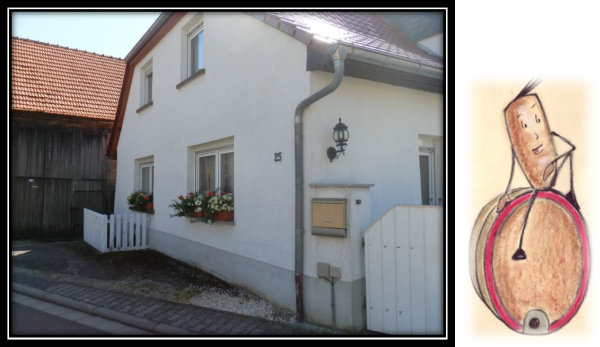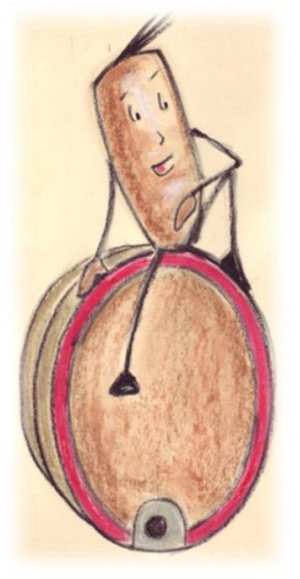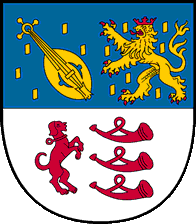Historischer Ortsrundgang Spiesheim
Der Spiesheimer Zappe
Eine wahre Geschichte über die Leichtgläubigkeit und den herrschenden Aberglauben noch zu Anfang des 19. Jahrhunderts verhalf den Spiesheimern zu ihrem Spitznamen. Peter Fuchs heiratete im Juli 1804 eine junge Spiesheimerin und wohnte fortan in diesem Haus.

Fuchs wurde 1769 in Offenbach am Main als Sohn eines Wasenmeisters (Abdecker: in einem bestimmten Bezirk für die Beseitigung von Tierkadavern und die Tierkörperverwertung zuständige Person) geboren. Er gab sich als studierter Viehdoktor aus oder verfügte er gar nur über gute Kenntnisse in der Tierheilkunde. Keine Überlieferung aus dieser Zeit brachte dazu endgültige Klarheit. Für die Spiesheimer war aber fortan ein "Dokter" im Ort, der sich um ihr krankes Vieh kümmerte. Sie schätzten ihn und sein Wissen sehr und schrieben ihm sogar übernatürliche Kräfte zu. Wenn ein Stück Vieh krank war, rief man den "Dokter" Fuchs. Er wusste so manches Mittelchen um dem kranken Tier zu helfen, sprach mit ihm, rieb ihm den Bauch und hatte auch öfters Erfolg mit seiner "Behandlung". Ob der trotzdem karge Lohn ihn dazu trieb, dem Erfolg etwas unter die Arme zu greifen oder andere Umstände dazu den Anlass gaben, wird wohl nie geklärt werden können.
Wie sich erst viel später herausstellte, begann Herr Fuchs seine arglosen Mitbürger zu betrügen.
Wenn mittags die ganze Bauernfamilie auf dem Feld arbeitete, schlich er sich in Hof und Stall und molk einmal eine Kuh außer der Zeit. Als diese am Abend zum Entsetzen ihrer Besitzer keine oder nur wenig Milch gab vermuteten die Bauern eine Krankheit und riefen den "Dokter" Fuchs. Dieser "erkannte" im Sachverhalt eindeutig das Werk einer Hexe und erbot sich, natürlich für entsprechende Entlohnung in Geld oder Naturalien, die Hexe zu bannen. Die Bauern willigten ein, denn sie wollten, dass ihr Vieh vom Fluch der Hexe befreit wird. Fuchs machte sich dann an die Arbeit, streichelte die "verhexte" Kuh, murmelte ein paar Zaubersprüche und schlug zu guter Letzt noch einen hölzernen Zapfen von einem Weinfass (Zappe) in die Stallwand. Zusätzlich versprach er, dass die Kuh bis zum nächsten Morgen vom Bann befreit sei und wieder ganz normal Milch geben werde. Da dies natürlich auch geschah, erhielt er von den Besitzern der Kühe, die nunmehr an die Wirkung der Zauberformeln glaubten, den verabredeten Lohn und gewann im Laufe der Zeit großes Ansehen. Fast in jedem Spiesheimer Stall hat er auf diese Weise sein Unwesen getrieben.
Bekanntlich geht jedoch der Krug so lange zum Brunnen, bis er bricht. Misstrauisch durch die allzu oft erfolgreich vorgenommene Hexenverbannung bewachten einige jüngere Leute ihre Ställe und erwischten den "Dokter" Fuchs, als er wieder heimlich die Kühe molk. Es setzte eine heftige Tracht Prügel und zusätzlich zeigte der damalige Bürgermeister Wagner den Herrn Fuchs bei der Polizei in Wörrstadt an. Fuchs musste auch eine Gefängnisstrafe abbüßen und ließ sich nie mehr in Spiesheim blicken.
Als sich die Geschichte in der Umgebung nach und nach herum sprach, dauerte es nicht lange und man nannte und nennt bis zum heutigen Tag die Spiesheimer: "Die Zappe".
Bezogen auf diese Geschichte lautet ein Vers aus dem Spiesheimer Lied wie folgt:
"Es war en Mann mit Name Fuchs,
der hot die ganz Gemo beluchst.
Er schlug en Zappe in die Wand
und sagt, er hätt´ die Hex´ gebannt"
*Gemo = Gemeinde
Hier ein Abbild des modern stilisierten "Zappe", das auf allen Schildern des Historischen Ortrundganges zu sehen ist:

Text L 16: Sigmund Jung - Oktober 2016
Bild: Erich Dexheimer
Logo: Agentur Franzen

